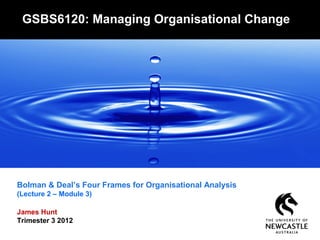
Bolman & Deal's Four Frames for Organisational Analysis
- 1. Bolman & Deal’s Four Frames for Organisational Analysis (Lecture 2 – Module 3) James Hunt Trimester 3 2012 GSBS6120: Managing Organisational Change
- 2. Lecture Outline Module 1: Background – Globalisation and its Impact on Organisational Change Module 2: Forces for Change - Hyper-competitiveness and Organisational Change Module 3: Four Frames for Understanding Change in Organisations .
- 3. Bolman & Deal’s Four Frame Analysis of Organisational Change Four Perspectives on Organisations: A Diagnostic Framework
- 4. The Structural Frame • Rules • Roles • Goals • Policies • Division of labour • Coordination of activities • Hierarchies
- 5. The Structural Frame • What are the task assignments within this organisation? • How are tasks/roles assigned and filled? • What are the overt/explicit goals and strategies of the organisation? • How does technology influence the organisation’s structure? • How specialised are tasks, roles, jobs, positions?
- 6. The Structural Frame Co-ordination and control: How are these two objectives balanced? Where does the final authority lie? Is this clear or unclear? Are rules and policies rigidly or loosely adhered to? Does the organisation have standard operating procedures? Does the organisation’s structure create, compound or facilitate problems?
- 7. The Human Resources Frame • Individual needs • Skills • Competency profiles • Relationships • Motivation levels • Enthusiasm • Harmony • Cooperation
- 8. The Human Resources Frame Is there a congruence between what individual employees need and what the organisation needs? Does two-way communication exist between various hierarchical levels? Does the organisation have leaders who believe in their people? Do they act on this belief?
- 9. The Human Resources Frame To what degree is there: - participation in decision-making? - support for idea-generation? - shared information? Does the organisation use rigid controls to monitor employee attendance and performance? What are management’s assumptions about employees? (resistant to change, lazy, unmotivated)
- 10. The Political Frame • Power • Influence • Coalitions • Alliances • Competition • Persuasion • Negotiation • Networks
- 11. The Political Frame • What coalitions can be identified in this organisation? (A coalition is a set of individuals who band together to pursue a particular goal or set of goals). • What boundaries does a particular coalition span? (eg: hierarchical levels, departments, professional groups, gender and ethnic sub-groups). • What enduring differences can be identified among individuals and groups in their value-preferences, beliefs, and perceptions of reality?
- 12. The Political Frame • What scarce resources may be identified, and how are they allocated? • Over what issues does conflict exist? • What power-bases exist? Who has them? Power bases include: 1. positional power (formal authority) 2. information and expertise 3. control of rewards 4. coercive power • Alliances, networks, control of agendas, control of meaning, personal power
- 13. The Symbolic Frame • Culture • Ritual • Ceremony • Stories • Heroes & heroines • Myths & legends • Symbols • Charisma
- 14. The Symbolic Frame Underlying meanings are important. What differences are there between the meanings attached to a particular event by different interest groups? Ambiguity and uncertainty: What examples are there of events, actions, or behaviour being ambiguous in meaning to people in the organisation?
- 15. The Symbolic Frame Difficulty in using rational approaches to problem-solving? What examples are there of problems being more easily solved by symbolic action than by logical action? Heroes and heroines: Who are the organisational heroes and heroines? What are the myths, legends and stories that surround them?
- 16. The Symbolic Frame Rituals and ceremonies are important. What examples are there of these? What ideologies do they reinforce?
- 17. Some Further Reading: • Hunt, J. (2003) Chapter 1: The Anatomy of Organisational Change in the Twenty-first Century. In Wiesner, R. & Millett, B. (Eds.), Human Resource Management: Challenges and Future Directions, John Wiley, Queensland. • Semler, R. (1989) ‘Managing Without Managers’, Harvard Business Review, Vol. 67, Iss. 5 (September-October): 76-84. Thank You for Viewing these Slides
